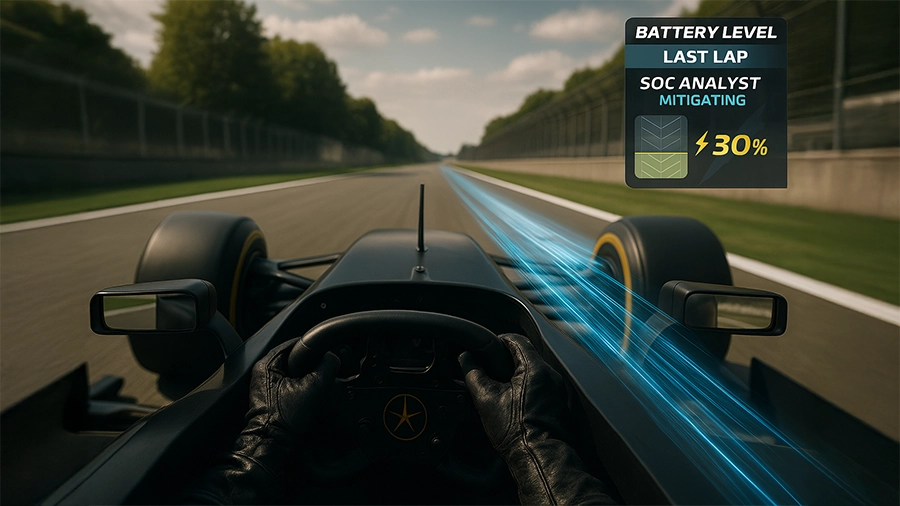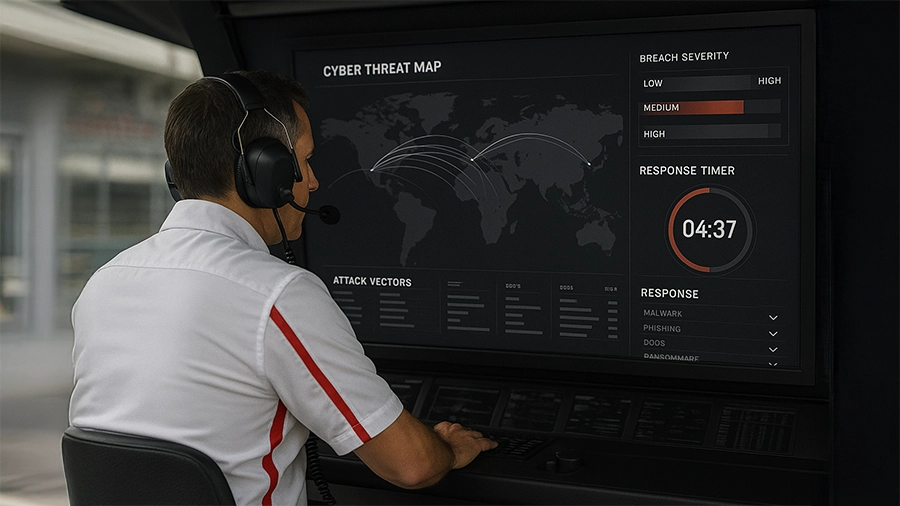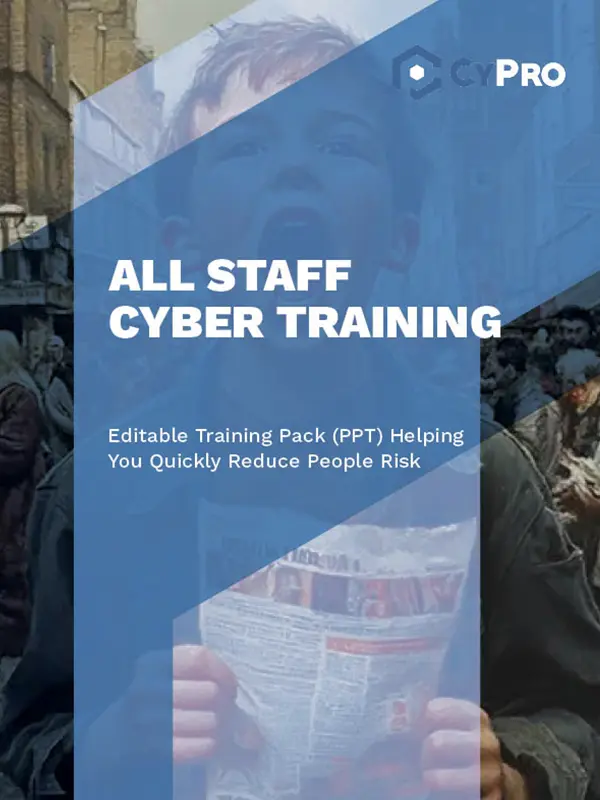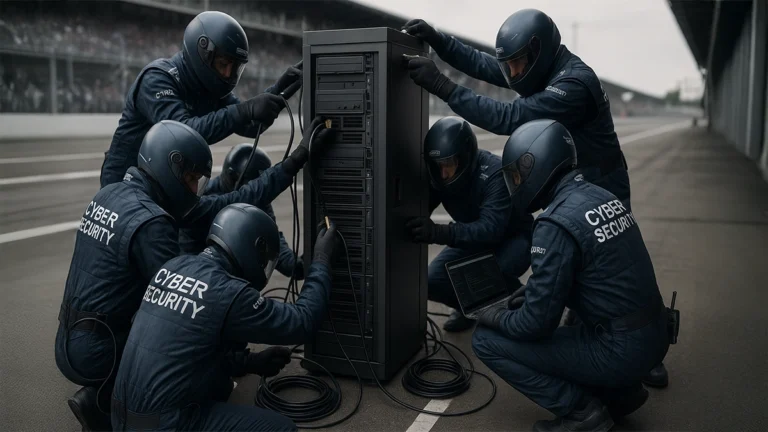Table of Contents
Formula 1 is the ultimate test of engineering, speed and human resilience. Behind every race lies an intricate system of data-driven decisions, teamwork and strategies designed to keep teams competitive under extreme pressure. In many ways, this mirrors the world of cyber security, where organisations must constantly adapt to shifting risks and recover quickly when things go wrong.
On the surface, Formula 1 and cyber security may seem worlds apart. One is a high-octane sport, and the other is a discipline of technology, risk management and compliance. Yet both share a reliance on:
- Data: F1 teams monitor every element of the car and driver; cyber teams monitor networks, applications and user behaviour.
- Speed: Split-second decisions determine whether a race, or a business, survives an incident.
- Resilience: Both require the ability to bounce back from setbacks without losing competitive advantage.
- Teamwork: Neither F1 drivers nor CISOs succeed alone. Behind each is a team of experts working in harmony.

Cyber resilience is seen as the ability to withstand, adapt and recover from cyber incidents without significant disruption to operations. This is exactly what Formula 1 teams do on track, where every race is a test of resilience as much as speed.
For businesses starting their journey, CyPro’s cyber resilience services provide frameworks to strengthen resilience from the ground up.
KERS and Energy Recovery – Learning from Setbacks

In Formula 1, the Kinetic Energy Recovery System (KERS) captures energy usually lost during braking and stores it to provide a powerful boost later down the track. It’s the art of turning a setback into an advantage, with wasted energy becoming race-winning power.
Cyber resilience follows the same principle. Every incident, whether it’s a phishing email, a malware infection, or even a failed penetration test, leaves behind valuable lessons. The organisations that thrive aren’t the ones that avoid every threat, but the ones that learn and adapt.
Turning incidents into resilience gains can include:
- Root Cause Analysis – analysing what went wrong and closing the gaps
- Penetration testing – simulating attacks to uncover weak spots before criminals do
- Red-team exercises – stress-testing defences and response in real-world scenarios
In 2019, Norsk Hydro was struck by the LockerGoga ransomware, forcing parts of the business back to manual operations. Instead of hiding the incident, they responded with transparency and resilience by restoring systems step by step while keeping production running. The experience drove major investments in security and continuity planning, turning a crippling attack into a long-term strength.
Learning from setbacks is at the heart of resilience. Just as KERS transforms braking into acceleration, organisations must use challenges as opportunities to build strength for the future.
Just like KERS transforms braking energy into a competitive edge, effective cyber resilience transforms setbacks into stronger defences and a more confident security posture.
DRS and Flexibility – Knowing When to Shift Gears

The Drag Reduction System (DRS) gives F1 drivers a temporary performance boost but can only be used under the right conditions. Deploying it at the wrong time can ruin a race.
Cyber resilience is no different. Resilience does not mean deploying every control at maximum intensity all the time, as that would slow the business down. Instead, resilience requires the ability to adapt. Knowing when to strengthen controls, such as multi-factor authentication across all users, and when to ease them for agility, such as enabling remote collaboration, is key.


Organisations that embraced adaptive strategies during the pandemic, such as adjusting remote access policies while still enforcing essential controls, are far more resilient against opportunistic phishing attacks, according to the UK Cyber Security Breaches Survey 2025.
Cyber resilience requires the ability to change strategy when conditions demand it, much like knowing when to activate DRS on the track.
Telemetry and Monitoring – Real-time Data Saves the Race
Telemetry is the nervous system of Formula 1. Each car generates thousands of data points per second, including tyre pressure, brake wear and engine heat, which are analysed in real time by engineers. This allows teams to detect anomalies and act before a minor issue becomes a catastrophic failure.
In cyber security, telemetry comes in the form of real-time monitoring. Security Operations Centres (SOCs), anomaly detection and Managed Detection and Response (MDR) services provide the same constant flow of data.
The UK Cyber Security Breaches Survey 2025 found that 43% of UK businesses reported a breach in the past year, with phishing leading the way. This highlights how essential monitoring and anomaly detection have become to keep pace with threats. Supporting this, IBM’s breach data shows that organisations with an internal, dedicated incident response team reduce breach costs by around $1 million compared to those identified by an attacker.
Real-time visibility helps organisations act with the same decisiveness as an F1 pit wall engineer spotting a problem before it ends the race.
Continuous monitoring is the telemetry of cyber resilience, enabling faster and smarter decisions.
Pit Stops and Incident Response – Speed, Precision and Roles

A pit stop lasting longer than 5 seconds can end a driver’s chances of winning. The key to success is not luck but preparation:
- Defined roles – each crew member knows exactly what to do
- Rehearsed to perfection – the process is drilled until it’s second nature
- Speed and accuracy – every second counts, mistakes aren’t an option
Incident response should operate the same way. Organisations that treat response as an afterthought often panic during real incidents. When a breach or attack hits, there’s no time to figure things out on the fly. Roles need to be clearly defined, communication channels established and the response plan practised. Organisations that treat incident response like an F1 pit stop being rehearsed, precise and team-driven, are the ones that can recover quickly and stay in the race.

Lessons from Formula 1 and Cyber Incidents
But just as a pit stop can win you the race, a badly managed one can ruin it. Formula 1 history has plenty of examples:
- In the 2021 Monaco Grand Prix, Valtteri Bottas’s race ended when his pit crew couldn’t remove a stuck wheel nut
- In 2019, Ferrari released Charles Leclerc without a wheel properly fitted, costing him the race.
In cyber, the same principle applies. If an incident is mishandled, the damage can be compounded many times. This can be seen through the likes of:
- Managing a breach by an unqualified responder
- Rushing actions that wipes forensic evidence.
Poor incident management has the ability to turn a contained breach into a full-blown crisis, with business costs far exceeding what would have happened if the organisation had done nothing at all.
The April 2025 Marks & Spencer cyber attack disrupted online shopping, “click and collect” services and caused estimated losses of £300 million. Clearer roles and faster rehearsed responses could have reduced the impact.
The lesson is that cyber resilience depends on practice, not panic. Just as every Formula 1 pit stop is rehearsed hundreds of times to achieve flawless precision under pressure, incident response must be treated the same way. Teams that regularly test their response plans, simulate attacks and refine their coordination are the ones that react calmly when a real incident strikes. Preparation turns chaos into control, which ensures that when every second counts, your team performs instinctively and effectively.
The fastest recoveries come from organisations that prepare, rehearse and know their roles.
Tyre Strategy and Business Continuity – Planning for Changing Conditions

In Formula 1, no tyre lasts forever. Teams must constantly adapt their tyre strategy to changing conditions such as rain, heat, track degradation, or even the behaviour of rival teams. One wrong call can cost a podium finish, no matter how fast the car is.
Business continuity works the same way. Plans that look solid today can quickly become outdated if they don’t evolve with the risk landscape. To stay resilient, organisations need to:
- Monitor conditions – track regulatory changes like GDPR or the UK’s Cyber Assessment Framework
- Adapt to new threats – update continuity plans as ransomware evolves and attack methods shift
- Factor in dependencies – prepare for supply chain vulnerabilities and third-party risks
- Review and refresh – continuity isn’t “set and forget”; it requires constant adjustment

Just as F1 teams win by making the right tyre call at the right time, resilient organisations succeed by keeping their continuity strategy flexible and responsive.
Keeping your strategy flexible and responsive means making mid-course corrections throughout the year as the threat landscape changes. Events such as a new ransomware variant, a zero-day in a critical supplier, or a geopolitical incident can all alter the risks your organisation faces overnight. If you’re not adjusting your plans in real time, you’re either not monitoring the right signals or you’re letting your cyber roadmap drift away from the external world.
In racing terms: you’re still on slick tyres while everyone else has switched to wets. The best teams, whether that be on track and in business, are those that see the change coming and pivot before the damage is done.
After a damaging attack, Gloucester City Council improved its continuity by introducing supplier risk dashboards, enhanced email security and stronger communication plans. The UK Electoral Commission also took nearly three years and significant funding to recover from a China-linked breach, underlining the long-term nature of resilience planning.
Both examples demonstrate that continuity planning is not about a one-off document, but an evolving practice. Cyber resilience requires continuity strategies that adapt to changing threats and environments.
Safety Cars and Recovery – Controlling the Damage

When crashes occur in Formula 1, the safety car is deployed to slow the race. It doesn’t repair the damage or get the car back on track, but it does neutralise risk, calm the chaos and create the space needed for recovery. Drivers regroup, teams reset and the race continues under controlled conditions.
Cyber resilience requires the same approach. The moment an incident strikes, the priority isn’t fixing everything instantly, you should be focusing on containing the threat to stop it spreading. This “safety car” phase buys valuable time for recovery and ensures the damage doesn’t spiral.
Key containment strategies include:
- Network segmentation – isolating compromised areas to stop lateral movement
- Device isolation – removing infected endpoints from the network immediately
- Failover systems – switching to backup infrastructure to keep critical services running
- Rate limiting or throttling – slowing malicious traffic while investigation takes place
In 2025, Jaguar Land Rover (JLR) was forced to halt production across multiple UK factories for over three weeks following a major cyber attack that disrupted critical systems. The shutdown, though costly, was a deliberate move to contain the threat and prevent it from spreading further across its network. The incident prompted JLR to strengthen its monitoring, network segmentation and supplier risk management, turning a severe disruption into a valuable resilience lesson.
Just like in Formula 1, a safety car cannot fix the problem but they prevent a bad situation from becoming catastrophic, giving teams the breathing space to regain control and recover.
Marginal Gains and Continuous Improvement
Formula 1 is a sport of fine margins. Races, and even championships, are often decided by tenths of a second. Teams don’t look for one giant leap forward; they focus on hundreds of tiny improvements, whether it’s shaving weight off a component, tweaking aerodynamics, or refining a pit stop routine. Over a season, those marginal gains add up to a winning edge.
Cyber resilience follows the same philosophy. There is rarely a silver bullet that fixes everything. Instead, resilience is built step by step, through constant improvements that strengthen people, processes and technology. Examples include:
- Timely patching – closing vulnerabilities before attackers can exploit them
- Regular staff training – reducing the risk of phishing or human error
- Improved governance – clear policies, accountability and leadership support
- Adopting new tools – threat intelligence, monitoring, or automation that incrementally improve defences
- Learning from every incident – post-mortems and small adjustments that prevent repeat mistakes
Just as an F1 team wins by stacking up countless small advantages, an organisation becomes cyber-resilient by embedding continuous improvement into its culture.
Building a Cyber Resilience Culture – Your Team is Everything

Behind every race-winning driver is a team of engineers, strategists, analysts and pit crews working in perfect sync. Formula 1 may look like a one-man show on the track, but it’s the ultimate team sport. A driver can’t win without the collective effort behind them.
Cyber resilience is no different. Technology alone won’t protect an organisation. Tools are essential, but the defences will eventually fail without people who know their role and buy into the mission. Building resilience into culture means:
- Leadership buy-in – executives must set the tone, making resilience a board-level priority rather than an IT issue
- Staff awareness – employees are often the first line of defence, so training on phishing, social engineering, and safe behaviours is critical
- Cross-department collaboration – IT, legal, HR, operations, and communications must all work together when incidents occur
- Shared responsibility – resilience isn’t owned by one department; it’s part of everyone’s daily role

Just like in F1, success also depends on specialist expertise working in harmony. Not everyone in the garage is a generalist: you have tyre engineers, aerodynamicists, data strategists and mechanics, each bringing deep knowledge to a critical function. Cyber security is the same, with needing the likes of incident responders, SOC analysts, cloud security engineers, compliance specialists and project managers.
A teams strength comes from cohesion and coordination, rather than operating in silos. Resilience depends not just on expertise, but on how seamlessly those experts coordinate.
When resilience is part of the culture, every employee becomes an active player in defence. Just as no F1 driver wins alone, no organisation can be truly resilient without its whole team working together.
From Track to Data Centre – Applying F1’s Mindset to Cyber Security
The biggest lesson Formula 1 offers is about mindset rather than speed on engineering. World Champions aren’t crowned because they avoid every mistake or crash, they win because they prepare for the worst, adapt strategies mid-race and keep improving on even the smallest of details.
Cyber leaders should adopt the mindset that resilience isn’t about building walls so high that nothing gets through, they need to prepare for the inevitable, adapt quickly and come back stronger.


Formula 1 Lessons in Cyber Resilience Terms
Here is how race-winning lessons translate into cyber resilience practices:
| Formula 1 Lesson | Cyber Resilience Translation |
|---|---|
| Winning requires strategy, not just raw speed | vCISO services: bringing strategic leadership without the full-time cost |
| Champions prepare for the worst, not just the best | Managed Detection & Response (MDR): real-time monitoring and containment of threats |
| Pit stops are rehearsed until flawless | Incident Response: practising crisis response until it becomes second nature |
| Every team member contributes to victory | Staff training: building awareness so every employee strengthens resilience |
Like in Formula 1, cyber success comes from preparation, adaptability and teamwork. Organisations that treat resilience as a living, evolving capability are the ones that turn setbacks into progress.
Final Thoughts
Formula 1 and cyber resilience may seem like two different worlds, but they are united by the same truth: victory doesn’t come from avoiding risk altogether – it comes from responding to it better than the competition.
Businesses that embed resilience into their culture, processes and technology won’t just survive the race. They’ll lead it.
Ready to strengthen your organisation’s resilience? Contact CyPro today and discover how our services can help you prepare, adapt, and stay ahead in the cyber race.











